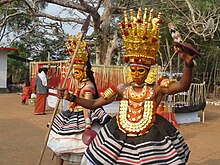Thirayattam

Thirayattam (ⓘ) is a ritualistic art form that is performed annually in the South Malabar region of the Indian state of Kerala. It is a tribal art form that combines dance, acting routines, songs, instrumental music, face writing, martial arts and rituals.
History
The art form had its origins from the tradition and customs of the Prehistoric era and the strange costumes and rituals in Thirayatam are reflections of the social life during the period.
Performance

Thirayattam is a tribal art form that combines dance, acting routines, songs, instrumental music, face writing, martial arts and rituals. The unique rituals, costumes and artistic performances differentiate Thirayattam from other art forms. It is usually enacted in courtyards called kaavukal (
Traditionally, the dance was performed by Perumannan and Vannan communities though other communities such as Panan and Cherumar also perform it. The performer usually reaches a trance state and enacts the moves of the "Moorthy" (deity) vigorously, exhibiting belligerent mannerism and gestures.[3]
Only men perform this art form. Thirayattam performers can take any of the three forms or Kolams which are Vellat, Thira and Chanthutira. Vellat kolams represent the childhood of the Murthis (deities), while Thirakolams represent the youth and Chanthuthira represent the grown matured form.[4] Various stories of mythological deities, local deities and idols are enacted. Ancient rituals like tree worship, Naga worship, nature worship, hero worship, mountain deity concepts, local deity concepts etc. are also practiced in Thirayattam. There are separate totams (scenes) for each story and the mythology of the deities is elaborated at length in each of the totams.
Each kolam has a separate face and script for enactment. The costumes and makeup materials are made from natural materials.
See also
References
- ^ G. Venu (1990). Puppetry and lesser known dance traditions of Kerala. Natana Kairali, Research and Performing Centre for Traditional Arts.
- ISBN 978-81-200-4294-0.
- ^ "Thirayattam". Thirayattam. Retrieved 10 September 2015.
- ISBN 978-8-185-69233-3.
- ^ Viṣṇunampūtiri, Eṃ. Vi (2012). Folklore: The Identity of Culture. Department of Information & Public Relations, Government of Kerala. p. 127.
- ISBN 978-0-944-14222-6.
- ISBN 978-8-120-60168-0.
